towing SATURN RELAY 2007 Owners Manual
[x] Cancel search | Manufacturer: SATURN, Model Year: 2007, Model line: RELAY, Model: SATURN RELAY 2007Pages: 570, PDF Size: 3.41 MB
Page 1 of 570
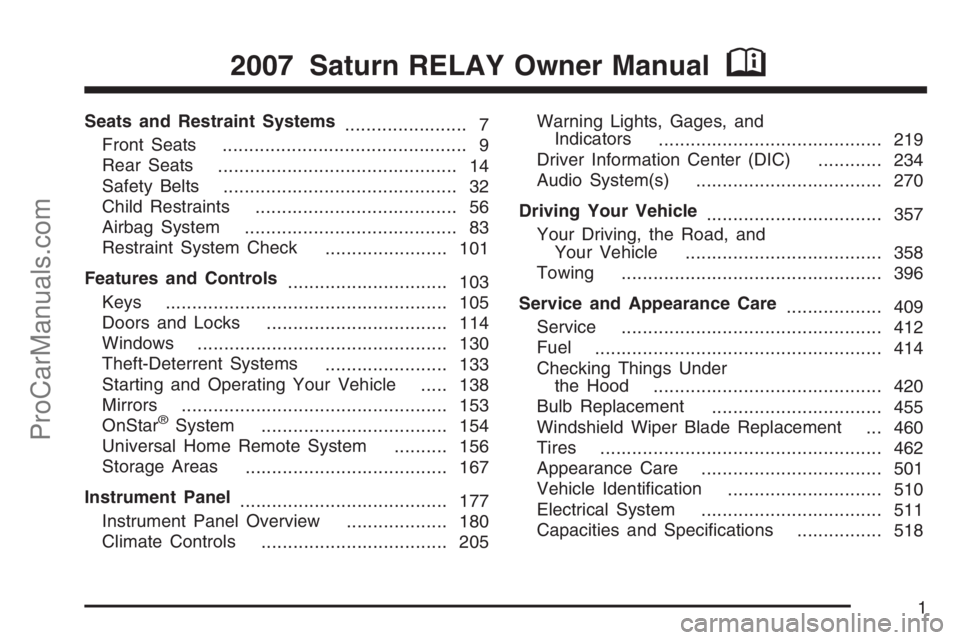
Seats and Restraint Systems
....................... 7
Front Seats
.............................................. 9
Rear Seats
............................................. 14
Safety Belts
............................................ 32
Child Restraints
...................................... 56
Airbag System
........................................ 83
Restraint System Check
....................... 101
Features and Controls
.............................. 103
Keys
..................................................... 105
Doors and Locks
.................................. 114
Windows
............................................... 130
Theft-Deterrent Systems
....................... 133
Starting and Operating Your Vehicle
..... 138
Mirrors
.................................................. 153
OnStar
®System
................................... 154
Universal Home Remote System
.......... 156
Storage Areas
...................................... 167
Instrument Panel
....................................... 177
Instrument Panel Overview
................... 180
Climate Controls
................................... 205Warning Lights, Gages, and
Indicators
.......................................... 219
Driver Information Center (DIC)
............ 234
Audio System(s)
................................... 270
Driving Your Vehicle
................................. 357
Your Driving, the Road, and
Your Vehicle
..................................... 358
Towing
................................................. 396
Service and Appearance Care
.................. 409
Service
................................................. 412
Fuel
...................................................... 414
Checking Things Under
the Hood
........................................... 420
Bulb Replacement
................................ 455
Windshield Wiper Blade Replacement
... 460
Tires
..................................................... 462
Appearance Care
.................................. 501
Vehicle Identi�cation
............................. 510
Electrical System
.................................. 511
Capacities and Speci�cations
................ 518
2007 Saturn RELAY Owner ManualM
1
ProCarManuals.com
Page 98 of 570

{CAUTION:
If the airbag readiness light in the
instrument panel cluster ever comes on
and stays on, it means that something
may be wrong with the airbag system. If
this ever happens, have the vehicle
serviced promptly, because an adult-size
person sitting in the right front
passenger’s seat may not have the
protection of the frontal airbag. See
Airbag Readiness Light on page 223for
more on this, including important safety
information.Aftermarket equipment, such as seat covers, can
affect how well the passenger sensing system
operates. You may want to consider not using seat
covers or other aftermarket equipment if your
vehicle has the passenger sensing system. See
Adding Equipment to Your Airbag-Equipped
Vehicle on page 100for more information about
modi�cations that can affect how the system
operates.
{CAUTION:
Stowing of articles under the passenger’s
seat or between the passenger’s seat
cushion and seatback may interfere with
the proper operation of the passenger
sensing system.
98
ProCarManuals.com
Page 138 of 570

Starting and Operating
Your Vehicle
New Vehicle Break-In
Notice:Your vehicle does not need an
elaborate break-in. But it will perform better
in the long run if you follow these guidelines:
Do not drive at any one constant speed,
fast or slow, for the �rst 500 miles (805 km).
Do not make full-throttle starts. Avoid
downshifting to brake, or slow, the vehicle.
Avoid making hard stops for the �rst
200 miles (322 km) or so. During this time
your new brake linings are not yet broken
in. Hard stops with new linings can mean
premature wear and earlier replacement.
Follow this breaking-in guideline every time
you get new brake linings.
Do not tow a trailer during break-in. See
Towing a Trailer on page 398for the trailer
towing capabilities of your vehicle and more
information.
Following break-in, engine speed and load can
be gradually increased.
Ignition Positions
The key can be turned to one of four positions
while in the ignition switch.
A (LOCK):This is the only position from which
you can remove the key. This position locks
your ignition and transaxle.
Notice:Using a tool to force the key from the
ignition switch could cause damage or break
the key. Use the correct key and turn the key
only with your hand. Make sure the key is all the
way in. If none of this works, then your vehicle
needs service.
138
ProCarManuals.com
Page 143 of 570
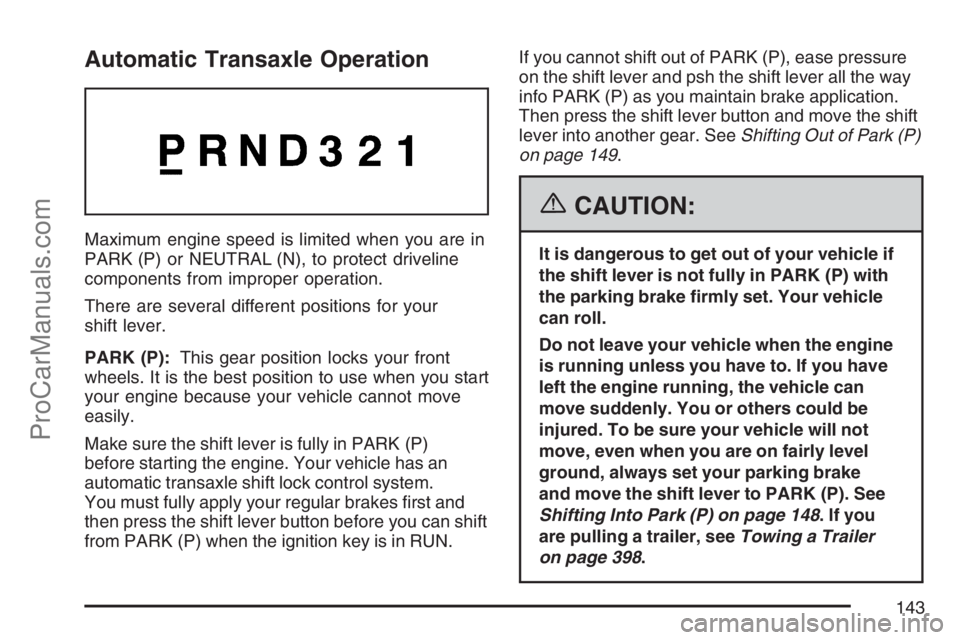
Automatic Transaxle Operation
Maximum engine speed is limited when you are in
PARK (P) or NEUTRAL (N), to protect driveline
components from improper operation.
There are several different positions for your
shift lever.
PARK (P):This gear position locks your front
wheels. It is the best position to use when you start
your engine because your vehicle cannot move
easily.
Make sure the shift lever is fully in PARK (P)
before starting the engine. Your vehicle has an
automatic transaxle shift lock control system.
You must fully apply your regular brakes �rst and
then press the shift lever button before you can shift
from PARK (P) when the ignition key is in RUN.If you cannot shift out of PARK (P), ease pressure
on the shift lever and psh the shift lever all the way
info PARK (P) as you maintain brake application.
Then press the shift lever button and move the shift
lever into another gear. SeeShifting Out of Park (P)
on page 149.
{CAUTION:
It is dangerous to get out of your vehicle if
the shift lever is not fully in PARK (P) with
the parking brake �rmly set. Your vehicle
can roll.
Do not leave your vehicle when the engine
is running unless you have to. If you have
left the engine running, the vehicle can
move suddenly. You or others could be
injured. To be sure your vehicle will not
move, even when you are on fairly level
ground, always set your parking brake
and move the shift lever to PARK (P). See
Shifting Into Park (P) on page 148.Ifyou
are pulling a trailer, seeTowing a Trailer
on page 398.
143
ProCarManuals.com
Page 145 of 570

DRIVE (D):This position is for normal driving.
It provides the best fuel economy for your vehicle.
If you need more power for passing, and you are:
Going less than 35 mph (55 km/h), push your
accelerator pedal about halfway down.
Going about 35 mph (55 km/h) or more, push
the accelerator all the way down.
The vehicle will shift down to the next gear and
have more power.
Downshifting the transaxle in slippery road
conditions could result in skidding, see Skidding
underLoss of Control on page 374
Notice:If your vehicle seems to start up
rather slowly or not shift gears when you go
faster, and you continue to drive your vehicle
that way, you could damage the transaxle.
Have your vehicle serviced right away. You can
drive in SECOND (2) when you are driving
less than 35 mph (55 km/h) and DRIVE (D) for
higher speeds until then.
Warm-Up Shift
Your vehicle has a computer controlled transaxle
designed to warm up the engine faster when
the outside temperature is 35°F (2°C) or colder.
You may notice that the transaxle will shift at
a higher vehicle speed until the engine is warmed
up. This is a normal condition designed to
provide heat to the passenger compartment and
defrost the windows more quickly. SeeClimate
Control System on page 205andDual Climate
Control System on page 209for more information.
THIRD (3):This position is also used for normal
driving. It reduces vehicle speed more than
DRIVE (D) without using your brakes. You might
choose THIRD (3) instead of DRIVE (D) when
driving on hilly, winding roads, when towing
a trailer, so there is less shifting between gears
and when going down a steep hill.
145
ProCarManuals.com
Page 147 of 570
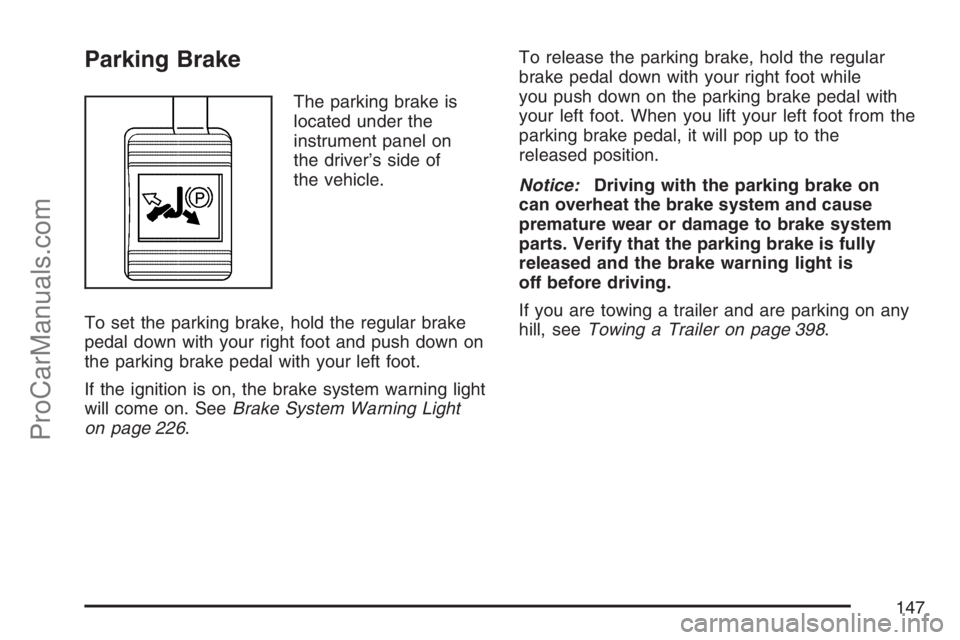
Parking Brake
The parking brake is
located under the
instrument panel on
the driver’s side of
the vehicle.
To set the parking brake, hold the regular brake
pedal down with your right foot and push down on
the parking brake pedal with your left foot.
If the ignition is on, the brake system warning light
will come on. SeeBrake System Warning Light
on page 226.To release the parking brake, hold the regular
brake pedal down with your right foot while
you push down on the parking brake pedal with
your left foot. When you lift your left foot from the
parking brake pedal, it will pop up to the
released position.
Notice:Driving with the parking brake on
can overheat the brake system and cause
premature wear or damage to brake system
parts. Verify that the parking brake is fully
released and the brake warning light is
off before driving.
If you are towing a trailer and are parking on any
hill, seeTowing a Trailer on page 398.
147
ProCarManuals.com
Page 148 of 570

Shifting Into Park (P)
{CAUTION:
It can be dangerous to get out of your
vehicle if the shift lever is not fully in
PARK (P) with the parking brake �rmly set.
Your vehicle can roll. If you have left the
engine running, the vehicle can move
suddenly. You or others could be injured.
To be sure your vehicle will not move, even
when you are on fairly level ground, use
the steps that follow. If you are pulling a
trailer, seeTowing a Trailer on page 398.
1. Hold the brake pedal down with your right foot
and set the parking brake with your left foot.
2. Move the shift lever into PARK (P) by pulling
the shift lever toward you and moving it up as
far as it will go.
3. Turn the ignition key to LOCK.
4. Remove the key and take it with you. If you
can leave your vehicle with the ignition key in
your hand, your vehicle is in PARK (P).
Leaving Your Vehicle With the
Engine Running
{CAUTION:
It can be dangerous to leave your vehicle
with the engine running. Your vehicle
could move suddenly if the shift lever is
not fully in PARK (P) with the parking
brake �rmly set. And, if you leave the
vehicle with the engine running, it could
overheat and even catch �re. You or
others could be injured. Do not leave your
vehicle with the engine running.
If you have to leave your vehicle with the engine
running, be sure your vehicle is in PARK (P)
and the parking brake is �rmly set before
you leave it. After you move the shift lever into
PARK (P), hold the regular brake pedal down.
Then, see if you can move the shift lever away
from PARK (P) without �rst pulling it toward you.
If you can, it means that the shift lever was
not fully locked into PARK (P).
148
ProCarManuals.com
Page 152 of 570
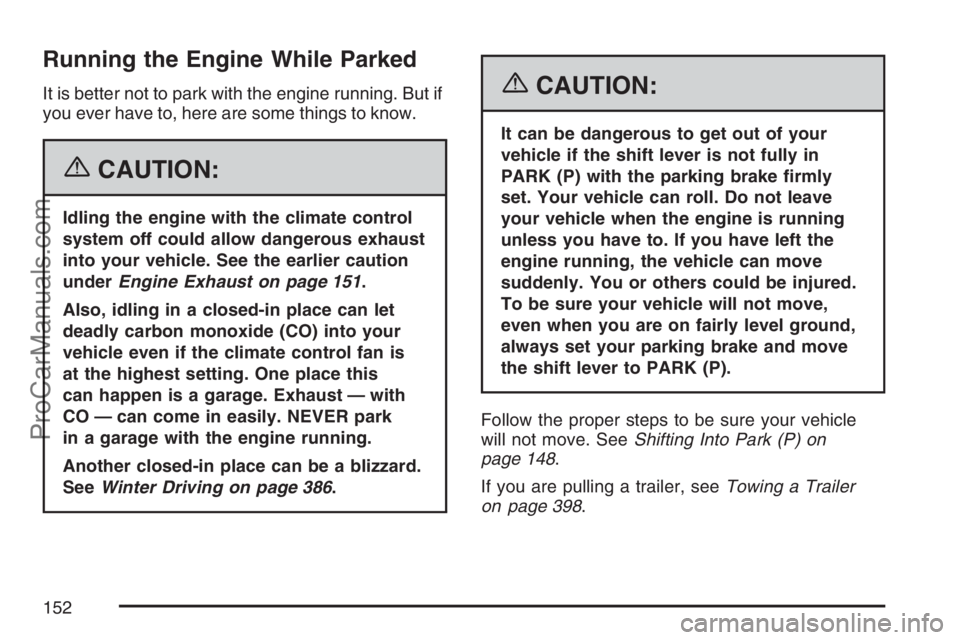
Running the Engine While Parked
It is better not to park with the engine running. But if
you ever have to, here are some things to know.
{CAUTION:
Idling the engine with the climate control
system off could allow dangerous exhaust
into your vehicle. See the earlier caution
underEngine Exhaust on page 151.
Also, idling in a closed-in place can let
deadly carbon monoxide (CO) into your
vehicle even if the climate control fan is
at the highest setting. One place this
can happen is a garage. Exhaust — with
CO — can come in easily. NEVER park
in a garage with the engine running.
Another closed-in place can be a blizzard.
SeeWinter Driving on page 386.
{CAUTION:
It can be dangerous to get out of your
vehicle if the shift lever is not fully in
PARK (P) with the parking brake �rmly
set. Your vehicle can roll. Do not leave
your vehicle when the engine is running
unless you have to. If you have left the
engine running, the vehicle can move
suddenly. You or others could be injured.
To be sure your vehicle will not move,
even when you are on fairly level ground,
always set your parking brake and move
the shift lever to PARK (P).
Follow the proper steps to be sure your vehicle
will not move. SeeShifting Into Park (P) on
page 148.
If you are pulling a trailer, seeTowing a Trailer
on page 398.
152
ProCarManuals.com
Page 184 of 570

LWindshield Washer. SeeWindshield
Washer on page 186.
ZRear Window Wiper. SeeWindshield
Washer on page 186.
=Rear Window Washer. SeeWindshield
Washer on page 186.
For information on the headlamps, seeExterior
Lamps on page 192.
Turn and Lane-Change Signals
The turn signal has two upward (for right) and
two downward (for left) positions. These positions
allow you to signal a turn or a lane change.
To signal a turn, move the lever all the way up or
down. When the turn is �nished, the lever will
return automatically.
An arrow on the
instrument panel cluster
will �ash in the direction
of the turn or lane
change.To signal a lane change, just raise or lower the
lever until the arrow starts to �ash. Hold it
there until you complete your lane change. The
lever will return by itself when you release it.
As you signal a turn or a lane change, if the arrow
�ashes faster than normal, a signal bulb may
be burned out and other drivers will not see your
turn signal.
If a bulb is burned out, replace it to help avoid an
accident. If the arrows do not go on at all when
you signal a turn, check for burned-out bulbs and
check the fuse. SeeBulb Replacement on
page 455andFuses and Circuit Breakers on
page 512.
If you have a trailer towing option with added
wiring for the trailer lamps, the signal indicator will
�ash at a normal rate even if a turn signal bulb
is burned out. Check the front and rear turn signal
lamps regularly to make sure they are working.
184
ProCarManuals.com
Page 227 of 570
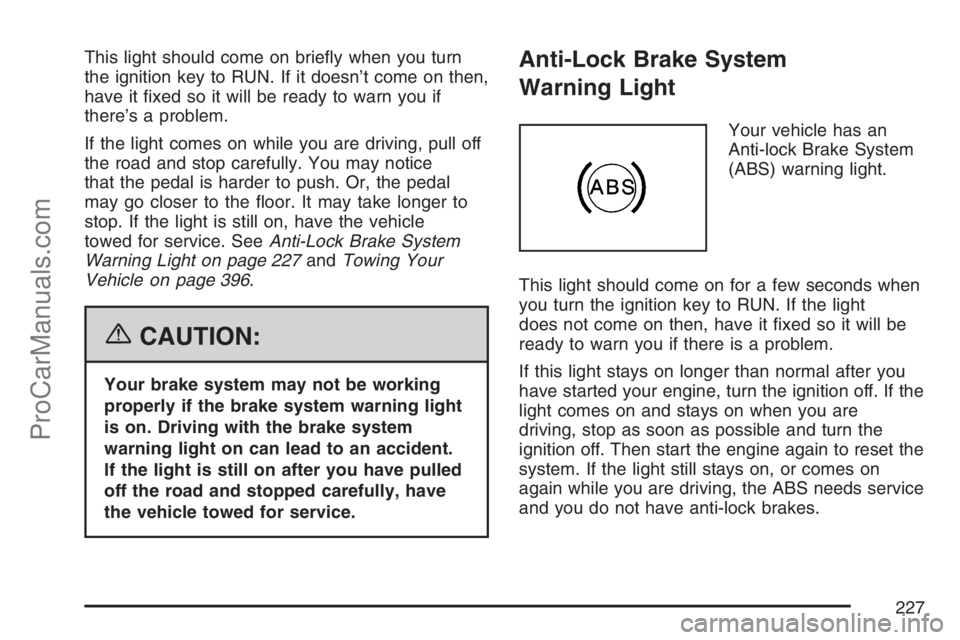
This light should come on brie�y when you turn
the ignition key to RUN. If it doesn’t come on then,
have it �xed so it will be ready to warn you if
there’s a problem.
If the light comes on while you are driving, pull off
the road and stop carefully. You may notice
that the pedal is harder to push. Or, the pedal
may go closer to the �oor. It may take longer to
stop. If the light is still on, have the vehicle
towed for service. SeeAnti-Lock Brake System
Warning Light on page 227andTowing Your
Vehicle on page 396.
{CAUTION:
Your brake system may not be working
properly if the brake system warning light
is on. Driving with the brake system
warning light on can lead to an accident.
If the light is still on after you have pulled
off the road and stopped carefully, have
the vehicle towed for service.
Anti-Lock Brake System
Warning Light
Your vehicle has an
Anti-lock Brake System
(ABS) warning light.
This light should come on for a few seconds when
you turn the ignition key to RUN. If the light
does not come on then, have it �xed so it will be
ready to warn you if there is a problem.
If this light stays on longer than normal after you
have started your engine, turn the ignition off. If the
light comes on and stays on when you are
driving, stop as soon as possible and turn the
ignition off. Then start the engine again to reset the
system. If the light still stays on, or comes on
again while you are driving, the ABS needs service
and you do not have anti-lock brakes.
227
ProCarManuals.com